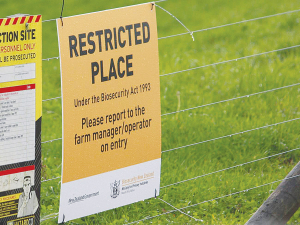We must keep our foot on the pedal
OPINION: Last week marked a major step forward in our work to eradicate Mycoplasma bovis.
 OSPRI has taken over day-to-day operational and disease control functions of the M. bovis programme.
OSPRI has taken over day-to-day operational and disease control functions of the M. bovis programme.
From this month OSPRI took over day-to-day operational and disease control functions of the Mycoplasma bovis (M. bovis) programme.
This means OSPRI will now be responsible for testing farms, the two background surveillance programmes, managing the current active confirmed property and any newly detected farms, depopulation of infected farms, or trace animals and supporting affected farmers.
Programme partners, Ministry for Primary Industries (MPI), Beef + Lamb New Zealand and DairyNZ, will continue to govern and monitor the programme's progress. MPI will retain non-operational aspects of the programme, including compensation, and any necessary compliance action.
OSPRI says the change does not affect farmers and M. bovis levies will not change.
The programme is now more than halfway into an estimated 10-year plan to eradicate M. bovis. The number of infected properties has fallen to very low levels and the major activity of the programme in coming years will be national surveillance of New Zealand's cattle herd. Moving operations from MPI to OSPRI at this stage of the eradication effort is said to provide the best value for the programme funders and farmers.
OSPRI says its proven regional management model reflects its experience in surveillance and disease control.
“The natural synergies between the M. bovis programme and our NAIT and the TBFree programmes will help us achieve operational efficiencies.
“A significant portion of our M. bovis team is coming over from MPI, bringing invaluable programme knowledge to our organisation.”
The M. bovis programme is being administered under a Government Industry Agreement (GIA) between the three partners.
A proposal is under way to change the administration model to a National Pest Management Plan (NPMP) — the same model used for bovine tuberculosis (TB). The proposal nominates OSPRI as the lead agency to deliver the programme for the remainder of the eradication plan.
Public submissions on the draft proposal closed in October 2023. The final proposal is expected to be submitted to the Government for review in 2024.
The Push-Up Challenge, an event which combines mental health and fitness, is set to launch in New Zealand in 2026.
Last month's Agritechnica event led to a wide group of manufacturers celebrating successes when the 2026 Tractor of the Year Competition winners, selected by a panel of European journalists, were announced in Hanover Germany.
According to the latest Federated Farmers banking survey, farmers are more satisfied with their bank and less under pressure, however, the sector is well short of confidence levels seen last decade.
Farmer confidence has taken a slight dip according to the final Rabobank rural confidence survey for the year.
Former Agriculture Minister and Otaki farmer Nathan Guy has been appointed New Zealand’s Special Agricultural Trade Envoy (SATE).
Alliance Group has commissioned a new heat pump system at its Mataura processing plant in Southland.
President Donald Trump’s decision to impose tariffs on imports into the US is doing good things for global trade, according…
Seen a giant cheese roll rolling along Southland’s roads?